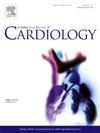纤维化-4评分在心力衰竭伴射血分数降低中的预后作用。
IF 3.2
2区 医学
Q2 CARDIAC & CARDIOVASCULAR SYSTEMS
引用次数: 0
摘要
背景:心力衰竭伴射血分数降低(HFrEF)和代谢功能障碍相关的脂肪变性肝病(MASLD)均与肝纤维化相关。HFrEF患者可因肝充血、MASLD或两者合并而发展为肝纤维化。纤维化-4 (FIB-4)评分根据年龄、天冬氨酸转氨酶、丙氨酸转氨酶和血小板计数计算,可作为晚期肝纤维化的筛查工具。本研究探讨了FIB-4评分与HFrEF患者的全因死亡率、心血管死亡率和主要不良肝脏结局(MALO)之间的关系。方法和结果:本研究纳入了来自丹麦心力衰竭登记处的4523例HFrEF患者。根据FIB-4评分,25.5% %为低风险,45.7% %为不确定风险,28.8% %为晚期肝纤维化高危。5年后,高风险组的累积全因死亡率为43% %,不确定风险组为36% %,低风险组为23% %。不确定风险和高危组的全因死亡率风险比(HR)增加(HR 1.33, 95 %置信区间[CI] 1.16-1.52;HR 1.51, 95 % CI 1.31-1.74)。同样,心血管死亡率的HR升高(HR 1.61, 95 % CI 1.27-2.05;HR 2.14, 95 % CI 1.67-2.74)和MALO (HR 1.77, 95 % CI 1.01-3.31;Hr 2.54, 95 % ci 1.43-4.52)。结论:HFrEF患者FIB-4评分高与死亡率和MALO增加相关。本文章由计算机程序翻译,如有差异,请以英文原文为准。

The prognostic role of Fibrosis-4 score in heart failure with reduced ejection fraction
Background
Heart failure with reduced ejection fraction (HFrEF) and metabolic dysfunction-associated steatotic liver disease (MASLD) are both associated with liver fibrosis. HFrEF patients may develop liver fibrosis due to hepatic congestion, MASLD, or a combination of both. The Fibrosis-4 (FIB-4) score calculated using age, aspartate aminotransferase, alanine aminotransferase, and platelet count, serves as a screening tool for advanced liver fibrosis. This study examines the association between the FIB-4 score and all-cause mortality, cardiovascular mortality, and major adverse liver outcomes (MALO) in patients with HFrEF.
Method and results
This study included 4523 HFrEF patients from the Danish Heart Failure Registry. Based on FIB-4 score, 25.5 % were low-risk, 45.7 % were indeterminate-risk, and 28.8 % were high-risk for advanced liver fibrosis. After five years, the cumulative incidence of all-cause mortality was 43 % for the high-risk group, 36 % for the indeterminate-risk group, and 23 % for the low-risk group. The indeterminate-risk and high-risk group had an increased hazard ratio (HR) for all-cause mortality (HR 1.33, 95 % confidence interval [CI] 1.16–1.52; HR 1.51, 95 % CI 1.31–1.74) compared to the low-risk group. Similarly, HRs were elevated for cardiovascular mortality (HR 1.61, 95 % CI 1.27–2.05; HR 2.14, 95 % CI 1.67–2.74) and MALO (HR 1.77, 95 % CI 1.01–3.31; HR 2.54, 95 % CI 1.43–4.52).
Conclusion
A high FIB-4 score in patients with HFrEF is associated with increased mortality and MALO.
求助全文
通过发布文献求助,成功后即可免费获取论文全文。
去求助
来源期刊

International journal of cardiology
医学-心血管系统
CiteScore
6.80
自引率
5.70%
发文量
758
审稿时长
44 days
期刊介绍:
The International Journal of Cardiology is devoted to cardiology in the broadest sense. Both basic research and clinical papers can be submitted. The journal serves the interest of both practicing clinicians and researchers.
In addition to original papers, we are launching a range of new manuscript types, including Consensus and Position Papers, Systematic Reviews, Meta-analyses, and Short communications. Case reports are no longer acceptable. Controversial techniques, issues on health policy and social medicine are discussed and serve as useful tools for encouraging debate.
 求助内容:
求助内容: 应助结果提醒方式:
应助结果提醒方式:


